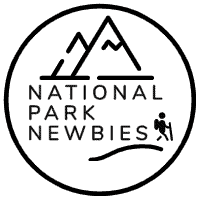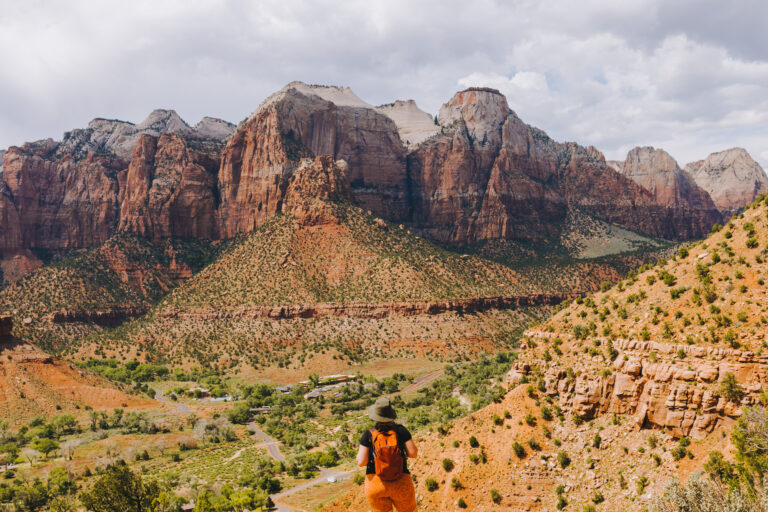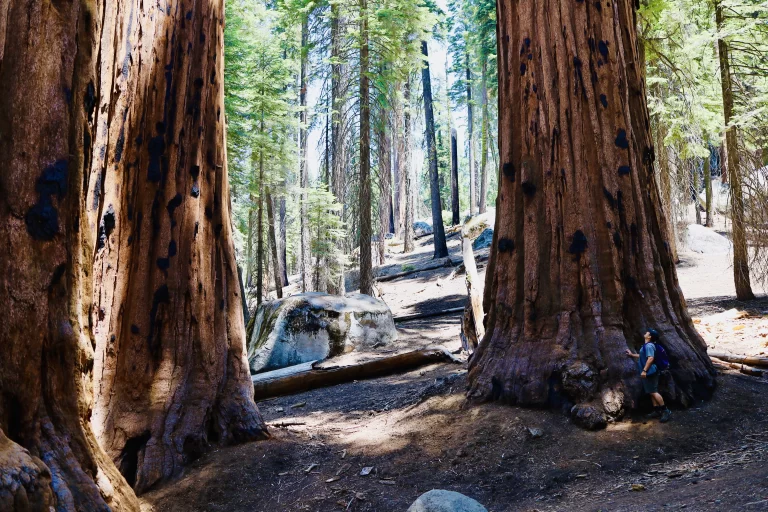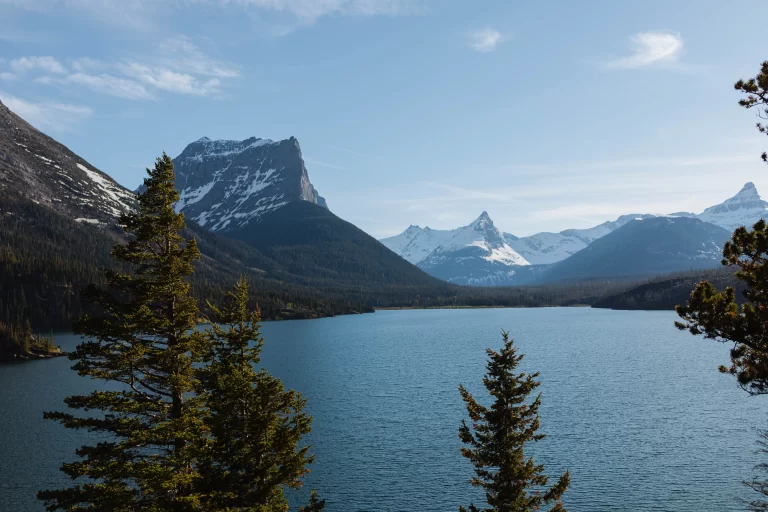Guide to Death Valley National Park for Beginners

Death Valley National Park is the perfect place for beginners – and it might be in our top 10 list of favorite parks ever!
Several other California national parks get more visitors per year:
- Yosemite National Park is iconic for its sweeping valley views.
- Sequoia is famous for its otherworldly giant trees
- Joshua Tree in the mysterious desert
There was something about Death Valley that left an imprint on us.
You can find peaks as high as any point in Glacier National Park.
AND you can stand at the lowest elevation point in North America.
It’s the largest national park in the lower 48 states (3.4 million acres).
There are salt flats, sand dunes, mountain ranges, badlands, stunning views, and long stretches of roads that reminded us of driving through remote parts of Utah.
And the popular areas are very accessible, making it as beginner-friendly as can be!
We loved Death Valley. We regret not visiting sooner.
Use this as your travel guide to Death Valley National Park.
Now, let us tell you everything you need to know about Death Valley National Park for Beginners!
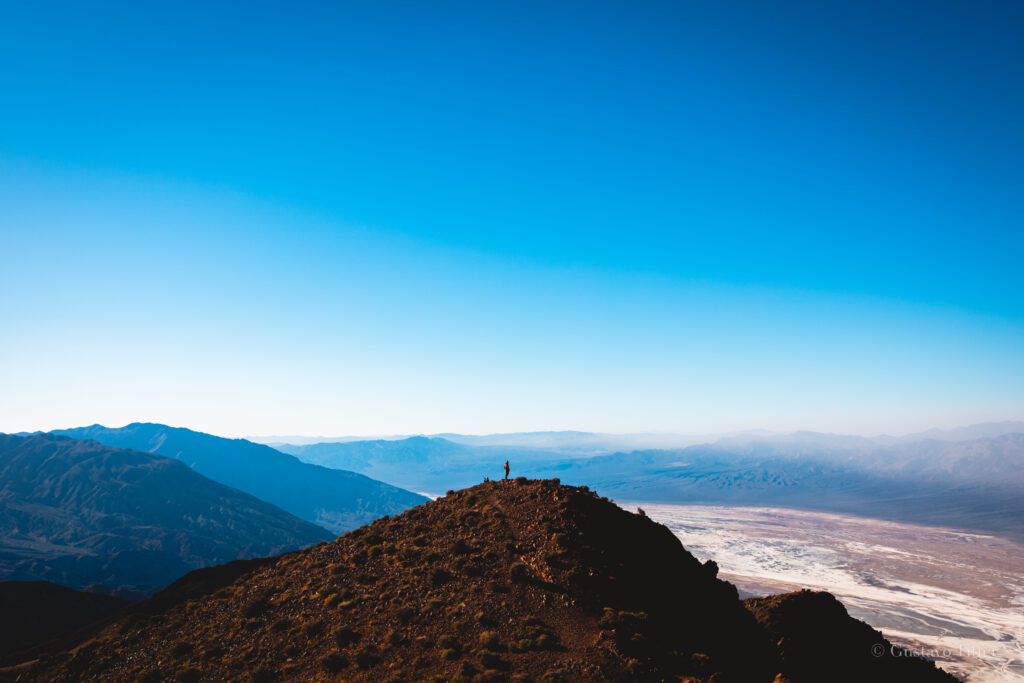
Notes from the Newbies

Katie
We put off visiting Death Valley for years. We wanted to visit more famous and “better” parks in California before we made time for Death Valley. We were so wrong. Death Valley is in our top 10 (maybe even our top 5). It feels like another world and we’re glad we got to step foot in it!
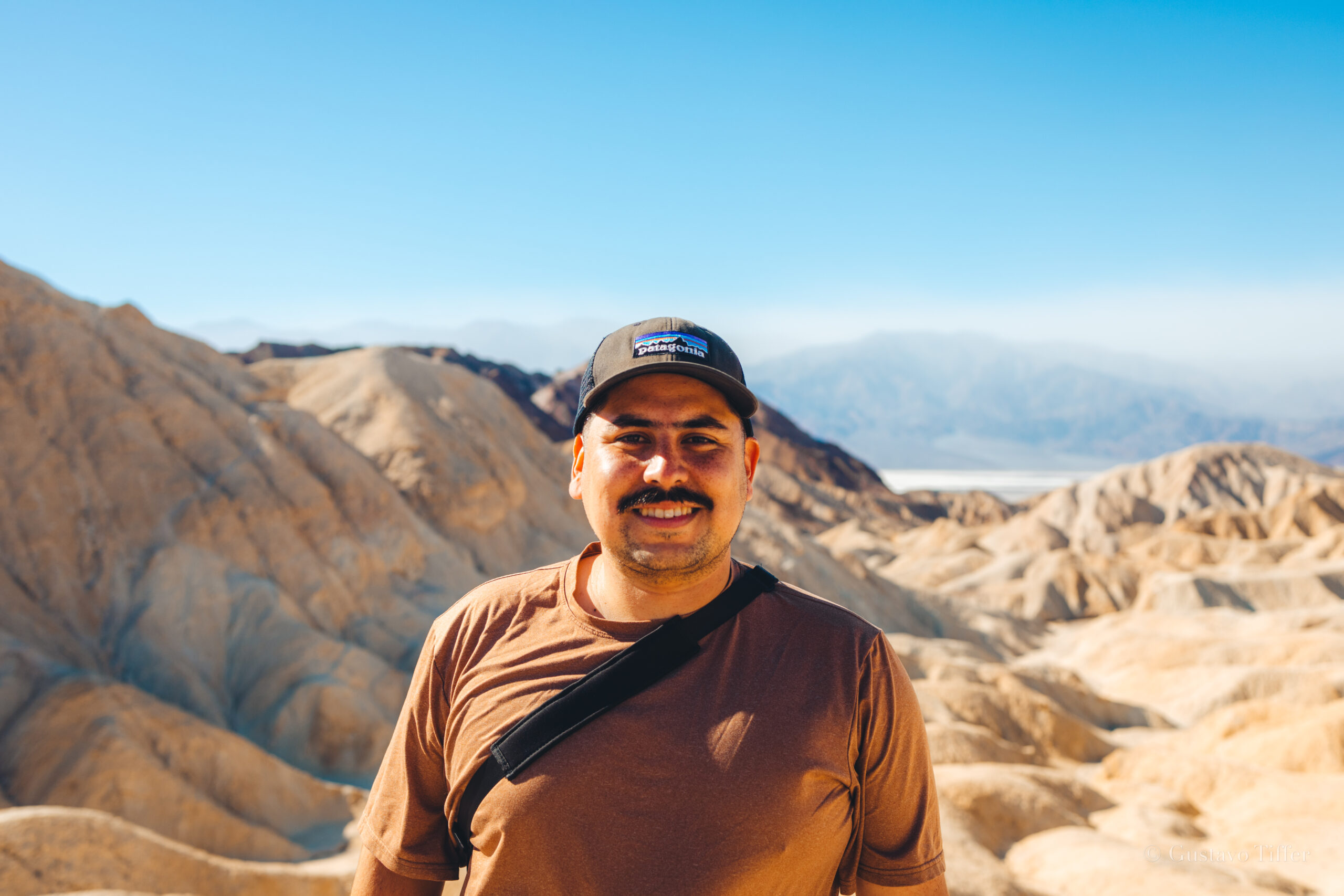
Gus
You can get everything you want in a national park at Death Valley: mountains, valleys, epic views, and truly unique experiences. As we literally drove off into the sunset, we immediately knew we had just visited one of our all-time favorite parks!
Death Valley Beginner Basics
| Date Established | 1994 |
| Annual Visitors | 1,128,862 |
| Rank in Popularity (by visitors) | 25th |
| Our favorite Hike | Dantes View |
| #1 Reason to Visit | Badwater Basin |
| Highest Visited Month | March |
| Lowest Visited Month | September |
| Best time to Visit | Winter (Dec. – March) |
| Ideal # of Days to Spend | 1-2 |
| Closest Major Airport | Las Vegas (126 miles) |
Map of Death Valley
We did not see large portions of the park (we’re beginners after all!). Death Valley spans 3.4 million acres, making it the largest national park in the lower 48 states.
We entered the park near Panamint Springs and stayed on CA-190 through the heart of the park for most of the trip.
There were several sections of the park closed to visitors during our trip (Nov. 2023) due to heavy rain and road damage sustained the year before.
Always check the NPS website for the most up-to-date information on road closures or special weather statements!

Top Tips For Visiting Death Valley National Park
Tip #1: Visit in the Winter Months

Death Valley is famous for being the hottest and driest place in North America. The record high temp was 134° in 1913, but temperatures consistently reach 120° throughout the summer months.
With very little shade coverage throughout the park, I can’t even imagine visiting in the summer!
That’s why we think the best time to visit Death Valley is in the winter months (Nov/Dec-Feb/March). We visited in November and got the most ideal temperature possible. The highs were in the mid-70s and the lows were in the low 50s.
The only downside is that campgrounds will likely be more full.
That’s okay though. We still recommend visiting in the winter unless you’d like to disintegrate on the spot!
Tip #2: Get in for Sunrise or Stay for Sunset

There is something truly magical about sunrise and sunsets in the desert – and Death Valley provided some of our favorites.
Driving into the park at sunrise gave us serene blue hues. The mountains slowly lit up the long stretches of road before us.
Driving out of the park at sunset gave us fiery orange glows. The mountain peaks again lit up and slowly faded as the light ran out.
I wish we would have spent a few more days in Death Valley just so we could catch another sunrise or sunset in a few more places.
Tip #3: Bring Plenty of Water and Sunscreen

As we already said, Death Valley is one of the driest places on earth.
Even in the cooler months (when we visited) you will need plenty of water. It’s easy to overlook heat exhaustion, especially if you think, “well, at least it’s not 120°!”
Shade is scarce throughout the park. Every short walk or hike we took had zero tree coverage. During our visit it was quite windy, so it made our lips and skin feel very dry.
You need to be prepared on any national parks trip you take. But I think it’s especially true in Death Valley given some of the extreme weather that can occur there.
Your safety is your responsibility – just pack a few extra bottles!
Tip #4: Prepare for LOTS of Driving

Most of our national parks trips have required way more driving than we expected – Death Valley was no exception.
We drive for a total of about 6 hours getting into, driving around, and getting out of the park.
It took us about 1 hour to get inside the park because we stayed in a nearby town called Trona (also called Searles Valley). It’s about as close as you can get to the west entrance of CA-190.
But even if you subtract drive time to/from our Airbnb, we still drove 4+ hours within the park.
Save these few gas stations along the way:
In our estimation, these were the most ideal stops for gas throughout the day.
All that to say, make sure your car is tuned up and ready to be on the road all day!
Tip #5: Peaks and Valleys

Something that made Death Valley particularly interesting was the fact that you could experience one of the highest peaks in the park (Dantes View) and the lowest point in the North America (Badwater Basin) all within one hour.
We’ve never been to a park that had such extreme elevation changes in a short amount of time. It usually feels like we experience a singular type of climate. The mountains of Washington or the deserts of Utah.
But Death Valley felt like a strange combination of high and low points.
This also meant we needed a variety of clothing. We experienced a 30-40 degree change all within one day.
At the top we needed multiple layers of clothing because it was so windy and cold!
At Badwater Basin I had shorts and a t-shirt on.
It’s by no means a negative experience, it simply means you have to plan on having a few layers to put on or shed – just in case.
Most Popular Hike in Death Valley: Badwater Basin
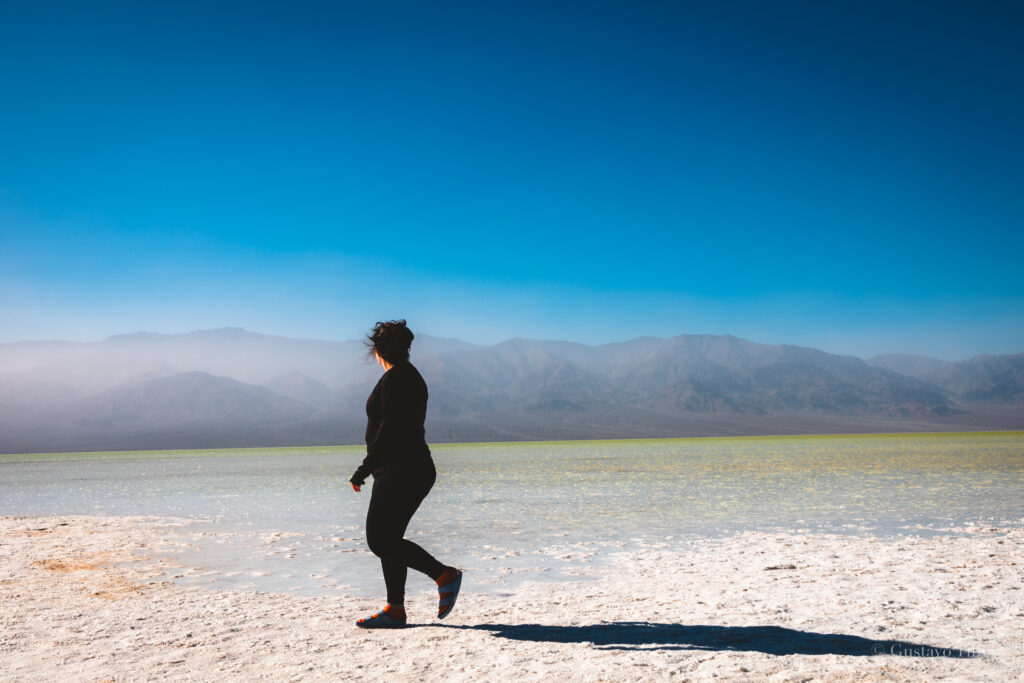
Badwater Basin is the most unique experience at Death Valley.
You find yourself standing at the lowest elevation in North America – 282 feet below sea level.
There’s an interesting sign bolted onto the mountainside behind the parking lot. It indicates where sea level is.
And we marveled at the fact that we were standing hundreds of feet below it. It’s a bit jarring only because we’re used to measuring places or things in reverse.
It was by far the most trafficked section of the park (but by no means unmanageable). We visited in the middle of the day and easily found parking.
Badwater Basin is a giant salt flat. You can meander onto a boardwalk and eventually onto the salt flat itself.

Fair warning – salt will stick to the bottom of your shoes! By the end of our time there, we spent a good 5 minutes banging our shoes on the pavement to knock off the sand.
But the most interesting part, was the lake that had formed in the basin prior to our trip.
You see, water isn’t supposed to form in Death Valley. It’s too hot. It’s too dry.
But in August of 2023, a big storm hit California (Tropical Storm Hillary) and deposited a year’s worth of rain in a single day.
The typically bone-dry basin formed a lake not seen since 2005.
We were truly delighted to see it. I even dipped my finger to taste the water. Saltier than salt.
Badwater Basin Basics
- Location: 18 miles south of the Furnace Creek Visitor Center
- Best Time to Explore: Before 10am in the summer months
- Length: 1 mile round-trip
- Average Time to Complete: 30 minutes to 1 hour (depending on how long you’d like to meander)
- Level: Easy
- Elevation Change: Zero (dare we say – negative?)
- Why it’s Popular: The lowest elevation in North America
Our Experience at Badwater Basin

The best part about Badwater Basin is that you can meander and admire the surrounding area. It’s not a challenging walk by any means. You could be done with it in 10 minutes if you wanted to!
But we recommend lingering for a while. It would be easy to check this off your list and keep going, but slow down!
Think about the fact that you are standing in one of the most unique areas in the country – in the world!
It was incredible for us to look up at the surrounding mountain 5,000+ feet above us where we had been standing just a few hours prior. And then to look down at our feet, 282 feet below sea level. It was one of those experiences that left us saying, “wow” over and over and over again.
Top Things to Do in Death Valley
We visited Death Valley in one day (more on that below), but here were our favorite experiences besides Badwater Basin! There is certainly much more to do – the park is 3.4 million acres after all!
But in one day, here’s what we were able to pull off
Dantes View

Dantes View is considered the best view at Death Valley. With 360º sweeping views of the surrounding landscape, it’s no wonder that people absolutely love this view – we did too!
It is located about 45 minutes south of Furnace Creek. Follow 190 south, past Zabriskie’s Point, and look for signs to turn right onto Dantes View Road.
This mountain peak that sits 5,475 feet of elevation and overlooks the entirety of Death Valley. Peering down, you can see Badwater Basin and the winding road leading to it. Looking across you can see Telescope Peak, another mountain top that sits even higher at 1,049 feet.
The road leading to the view is as scenic as they come. It feels like you are driving through the remote desert. You will gradually gain elevation, but there are not too many switchbacks until you get to the last ¼ mile.
The last ¼ mile are 15% grade, meaning you are climbing a fairly steep incline. Thankfully, our mini-SUV was able to easily handle it! But no trailers over 25 feet are allowed all the way up (don’t worry, there’s a parking lot below where you can leave your trailer).

Once you arrive, you can check out the signage and step out onto the paved overlook area. Or you can meander down a short hiking trail just beyond the lot (we recommend this!). You can climb up a few mounds or rock/dirt and get even more scenic views and pictures of the valley below.
It was breathtaking to stand up on Dantes View – one of our favorite views in any national park!
Zabriskie Point & Badlands Loop
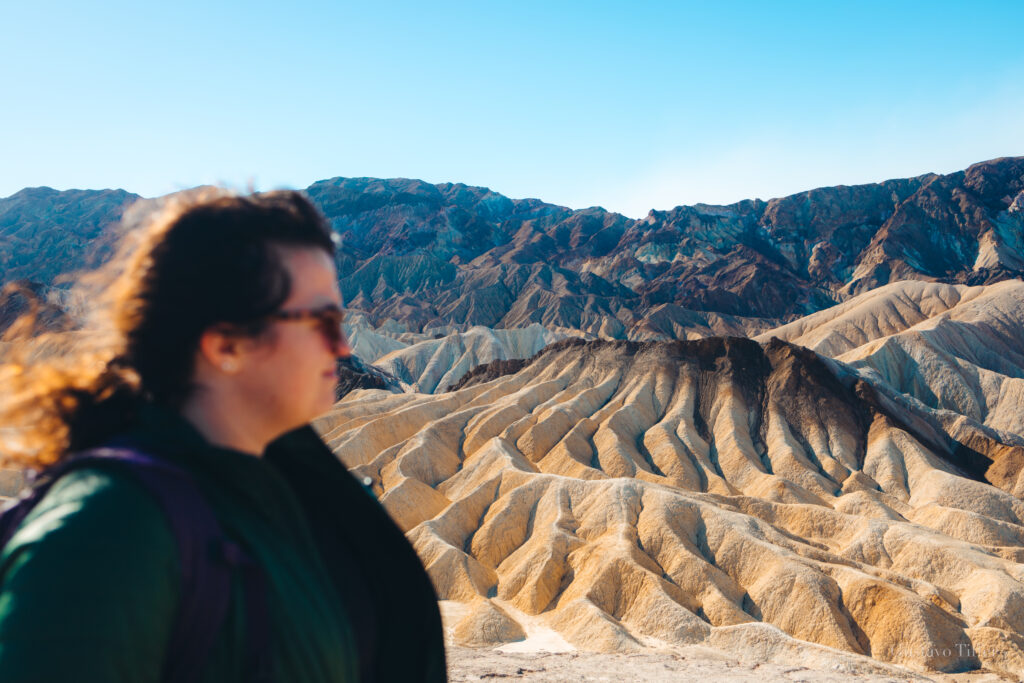
Zabriskie Point is another iconic and must-see stop at Death Valley. From here you can get really unique pictures of the surrounding badlands, mountains, and the valley. It’s probably the second-most popular stop in the park behind Badwater Basin.
Park in the lot and climb the 100 yards up to Zabriskie Point. From here you can get a colorful view of the badlands around you. We were stunned by the colors and hues at Zabriskie Point. You could clearly see the formation of the rock by water and wind over the eons.
Our favorite part of this area was the Badlands Loop. Located just off the parking lot, the Badlands Loop is a 2.4 mile round trip hike that takes you into the badlands area. It was fairly easy, becoming moderate on the way back up.
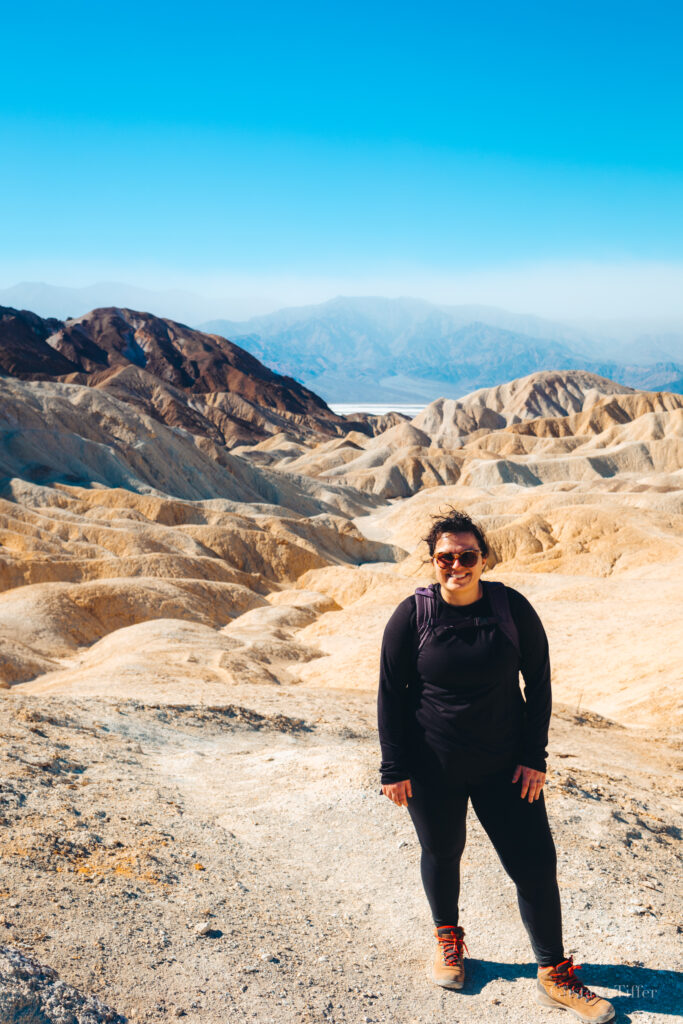
Make sure you take plenty of water, hats, and sunscreen on this particular hike. There is nearly zero shade. We recommend hiking the trail clockwise, it will give you the best views at the end!
You have the option to connect to the Golden Canyon Trail. We saw a bunch of signs and recommendations for this hike, but it would have been too long for us. Next time!
Artists Palette and Artists Drive Scenic Loop

Artists Drive Scenic Loop is located along Badwater Basin road – about 20 minutes from the visitor center.
The Artists Drive is a 9 mile loop going south to north and Artists Palette is located 5 miles into the loop – right at the center.
This area is famous for the colorful rocks – green, blue, and red hues surround the area. The colors stand out and are extremely unique given that most of Death Valley is brown and dusty.
Once you get to the Artists Palette section, there is a small parking lot and a few trails leading into the little canyon. You can get right up to the colorful rocks, take pictures, and even hike among them. We went in the early afternoon, but I imagine this place explodes with color at sunrise or sunset.

The loop should take you between 30-45 minutes to complete. It’s a bit of a detour off Badwater Basin road, but it is entirely worth it to get a view of these unique and colorful rocks in the middle of the desert!
Mesquite Flat Sand Dunes

The Mesquite Flat Sand Dunes are another example of just how diverse the ecosystem is at Death Valley.
The sand dunes are located just past Stovepipe Wells, about 25 minutes north of the Furnace Creek visitor center.
There is a fairly large parking lot where you can gear up and start walking among and on top of the sand dunes. You can take a 2 mile round trip hike to the largest dune, but we simply strolled around the area.
We went near sunrise and got some really dramatic colors of the sun rising over the mountains and lighting up the dunes area. It’s a view that I won’t soon forget.

Fair warning, your stuff will get dusty! It was particularly windy on the day we went, so we had to cover our faces on a few occasions.
And I won’t lie to you – I found a sh*t ton of sand in my bag once I got home from the trip!
Stargazing

On our first night in Death Valley, we drove out onto CA-190 and parked along the side of the road to admire the stars.
The moon was out so we didn’t get the best view, but the stars were spectacular nonetheless.
Death Valley is an international dark sky park and has some of the darkest skies in the entire U.S. Some of the best places to view the night sky at Death Valley are at the Mesquite Flat and Badwater Basin.
There are also ranger-led programs that introduce beginners to the night sky. We were unable to visit, but you can learn more about them here.
No matter whether you take a formal tour or head out on your own, trying to see the night sky is a must when visiting Death Valley. There’s nothing quite like it!
Death Valley National Park in One Day

Visiting Death Valley in one day is absolutely doable. As long as you start your day early and plan on staying until the late evening, you can get nearly everything done that we’ve talked about today and more.
In hindsight we wish we would have had just one more day at Death Valley, but again one day is absolutely doable.
- Morning: Sunrise at Dantes View and Hike around Zabriskie’s Point
- Mid-day: Explore Stops Along Badwater Basin Road
- Late afternoon: Sunset at Mesquite Flat Sand Dunes
Depending on where you stay in or near Death Valley, you should plan for a really early morning.
We stayed about 1 hour outside of the park in nearby Searles Valley / Trona. It took us 1.5 hours to get to the Mesquite Sand Dunes for sunrise. If we would have wanted to see the sunrise at Dantes View, it would have taken us 2.5 hours.
In other words, you have to get up early! Set your alarm for 4am and get going as quickly as you can.
You should also plan for lots of driving as well. As we previously, we drove for 4+ hours just within the park.
Lastly, don’t worry even if you don’t get to everything. While you may feel the pressure to push yourself and explore every last bit of the park, the truth is that you just can’t in one day. There’s too much to do and too little time (as they say).
If you follow all the things we’ve outlined in this post, we think you will get the most out of Death Valley in one day!
Final Thoughts: Death Valley National Park for Beginners
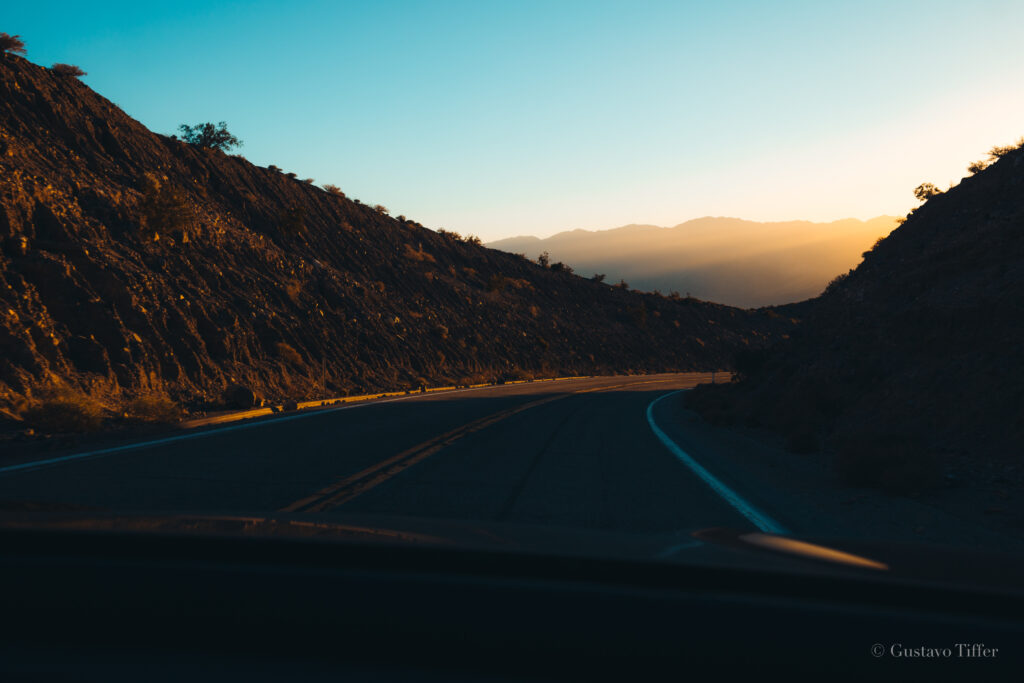
Death Valley National Park is a fantastic place for beginners.
We loved how accessible and drivable it was. We loved that you could see the very best views of the park without needing to really strain your body.
Don’t get me wrong, some of our favorite experiences at the national parks have been the tough-to-reach places. But there’s something amazing about a park that lets you see the best of it with relative ease.
Death Valley is severely underrated. I lived in California my entire life and Death Valley was really just associated with the word “hot.” But there’s so much more to it and it’s as diverse as they come.
Sure, there aren’t any forests or giant trees, but there’s sand dunes, tall peaks, low valleys, and – luckily for us – one of the most unique lakes we ever had the chance to see.
Death Valley is now in our top 5 parks we’ve ever visited. And we can’t wait to go back some day.
You will feel alive in Death Valley and I suspect you will love it too.
